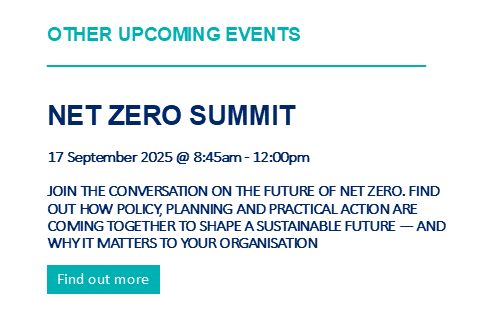- Details
Raising integrity voluntarily: The UK’s carbon and nature markets consultation
Steve Gummer explores the most recent consultation from the UK Government on making positive changes to carbon and nature credits.
|
Jargon buster:
|
The UK Government’s latest consultation, “Voluntary Carbon and Nature Markets: Raising Integrity”, outlines a detailed framework for improving trust in the use of carbon and nature credits.
It sets out six voluntary “integrity principles”, supports international standards, and proposes better guidance on claims and disclosures.
It is comprehensive in scope and aligned with wider international efforts. It does not, however, impose any binding requirements, at least not yet.
The task for any Government is a tricky one. Regulate enough so as to ensure genuine carbon offsetting and claims with integrity, but don’t regulate so much that a nascent market is gutted before it takes its first breath.
The Government’s approach reflects a careful balancing act: encouraging better market practice without deterring participation or pre-empting global alignment.
The purpose of the consultation
Voluntary carbon and nature markets allow organisations to buy credits that represent either avoided or removed greenhouse gas emissions (in the case of carbon), or measurable environmental improvements (in the case of nature).
These credits are used to support sustainability strategies and, in many cases, underpin public claims such as “carbon neutral” or “net zero”.
As public scrutiny of these markets has increased, so have calls for better governance. This latest consultation sets out a non-binding but structured response, intended to guide the evolution of high-integrity credit use while enabling flexibility, innovation, and international coordination
The six principles of the consultation
1. Credits should only be used in addition to emissions reduction
The first principle sets a clear expectation: credits should only be used to address residual emissions that cannot be feasibly eliminated.
The Government proposes to endorse the VCMI Claims Code of Practice, which allows companies to make credible claims about credit use only if they have science-based targets and are demonstrably reducing emissions across Scope 1, 2 and 3.
For companies not yet able to fully reduce Scope 3 emissions, the VCMI Beta Scope 3 Claim (for the uninitiated, this is a provisional labelling system developed by the Voluntary Carbon Markets Integrity Initiative (VCMI).
It allows companies to use high-quality carbon credits temporarily to address hard-to-abate Scope 3 emissions, while they work to reduce them provides a time-limited way to use credits transparently).
The Government also raises the possibility of a new transitional label – potentially called something like “Towards Paris Alignment” – for organisations that do not yet meet full VCMI criteria but are reducing what they can and using only high-quality credits. Could this label be administered by the Government directly, or through a delegated body? That remains open.
The topic of insetting is raised a lot. What is insetting?
JARGON BUSTER: Insetting refers to projects that reduce emissions within a company’s own supply chain, such as supporting farmers to adopt low-emission practices.
For example, a chocolate manufacturer might help cocoa suppliers shift to regenerative agriculture, lowering Scope 3 emissions.
The Government proposes supporting the wider adoption of such approaches, particularly in land-heavy sectors.
2. Credits must meet minimum quality standards
The Government proposes to endorse the Integrity Council for the Voluntary Carbon Market (ICVCM) Core Carbon Principles as the minimum threshold for credit quality.
These include requirements for additionality, permanence, conservative baselines, and independent verification.
For the UK market, the British Standards Institution (BSI) is developing a suite of Nature Investment Standards (NIS). These will cover carbon, biodiversity, nutrients, and community benefit.
Would there be value in formally linking compliance with these standards to an official Government label for UK-issued credits?
Such a step could help buyers and the wider public identify trustworthy credits at a glance. The purpose of NIS’ are:
- Scheme developers can design their programmes around them (e.g. a future soil carbon crediting scheme).
- Buyers can use them to assess the credibility of credits.
- Assurance bodies can audit against them (a formal assurance system is in development).
- Policymakers may use them to set benchmarks for funding or procurement.
3. Credit use should be disclosed clearly and consistently
Transparency is central to integrity.
The consultation proposes updating the UK’s Environmental Reporting Guidelines
JARGON BUSTER: This is Government-issued guidance to help companies report on greenhouse gas emissions, energy use, and other environmental impacts.
Quoted companies and large UK companies must report certain emissions under mandatory regulations, and the ERG supports this, but the guidelines themselves are not legally binding.
Companies are not required to use the ERG, but doing so helps ensure compliance and follow best practice, especially for voluntary disclosures) to incorporate key elements from:
- The VCMI Claims Code, which includes disclosure rules for any public claims involving credit use.
- The ISSB Climate Disclosure Standard (S2), a global standard that requires companies to disclose how carbon credits support climate targets.
- The UK’s Transition Plan Taskforce (TPT) framework, which encourages companies to explain how credit use fits within long-term decarbonisation plans.
Who is expected to disclose? The emphasis is on large companies, particularly listed firms and financial institutions.
Others are encouraged to follow suit. Could this voluntary expectation evolve into a baseline for participation in Government-backed schemes, or for making public claims? The consultation does not rule that out.
4. Credit use should be part of a long-term transition plan
Rather than being an annual offsetting exercise, the consultation proposes that credit use should be integrated into long-term climate transition planning.
JARGON BUSTER: This means that instead of buying credits each year to claim “carbon neutrality”, a company would set a long-term plan to cut its own emissions by, say, 90 per cent by 2040.
It would only use credits for the small share of emissions it genuinely can’t eliminate, and this would be clearly set out in its transition plan.
For example, an airline might use credits to cover unavoidable emissions from long-haul flights while investing in low-emission aircraft and sustainable fuels over time.
This is aligned with the Government’s commitment to consult on mandating credible transition plans for FTSE 100 companies and financial institutions.
In the meantime, companies are encouraged to adopt the voluntary TPT framework, which already includes expectations for disclosing credit strategy and use.
5. Environmental claims should be accurate and evidence-based
There is growing concern about the inconsistency of claims like “carbon neutral” or “biodiversity positive”.
The Government offers two options:
- It could define key terms in official guidance or legislation, or;
- Commission the development of a dedicated UK standard for green claims.
Either route would clarify when and how terms can be used, and what evidence is required.
Meanwhile, regulators such as the CMA and ASA are already enforcing existing consumer protection rules.
Playing devil’s advocate, there is actually a route to hard regulation and enforcement here.
Organisations like the ASA and CMA could enforce these principles through their existing codes. The ASA could update advertising rules to require evidence aligned with Government-endorsed standards.
The CMA could expand the Green Claims Code to treat vague or unverified claims as misleading.
This would make using standards like VCMI the safest way to make claims without legal risk.
Even without new laws, this creates a “soft obligation” where following the standards becomes the only credible option.
6. The market infrastructure must be coherent and interoperable
The final principle addresses coordination. The Government proposes:
- Supporting common legal definitions (e.g. through the Digital Assets Bill confirming credits as a form of property)
- Supporting registry interoperability through the Climate Action Data Trust
- Establishing a cross-regulator working group across environmental, financial, and competition regulators
- Exploring longer-term options, such as a governance body or independent ombudsman
In addition, the Government supports trialling more flexible credit structures (such as stacking – JARGON BUSTER: This is where one project produces more than one type of credit) and helping UK projects access international markets under Article 6 of the Paris Agreement.
Is the framework mandatory?
The entire framework is voluntary. The Government is proposing to influence behaviour through endorsement, recognition, guidance, and alignment, not through legislation.
The underlying reasons are sound: voluntary markets are inherently non-mandatory; international standards are still developing; and overregulation could deter participation or pre-empt international consensus.
But a reasonable question arises: if these principles and standards represent best practice, why not require them for organisations making public claims or participating in UK-linked schemes?
Could endorsed standards eventually form a baseline for doing business credibly in this space?
What would stronger action look like?
A more prescriptive approach could include:
- Requiring that any company making climate-related claims must comply with VCMI or equivalent standards
- Mandating disclosure of credit use for large companies
- Creating a public-facing Government label for credits or organisations meeting endorsed standards
- Would such measures provide clearer incentives for good practice and stronger protection against misuse, without unduly constraining innovation or flexibility?
This consultation is thoughtful and well-structured. It sets expectations, aligns with international frameworks, and defines a path towards higher integrity.
The Government has chosen to keep the framework voluntary, for now.
The next question is whether voluntary adherence is enough to deliver the credibility, transparency and consistency that these markets need — or whether some future form of structured obligation will be required.
Steve Gummer is a Partner at Sharpe Pritchard LLP.
For further insight and resources on local government legal issues from Sharpe Pritchard, please visit the SharpeEdge page by clicking on the banner below.
This article is for general awareness only and does not constitute legal or professional advice. The law may have changed since this page was first published. If you would like further advice and assistance in relation to any issue raised in this article, please contact us by telephone or email
|
Click here to view our archived articles or search below.
|
|
ABOUT SHARPE PRITCHARD
We are a national firm of public law specialists, serving local authorities, other public sector organisations and registered social landlords, as well as commercial clients and the third sector. Our team advises on a wide range of public law matters, spanning electoral law, procurement, construction, infrastructure, data protection and information law, planning and dispute resolution, to name a few key specialisms. All public sector organisations have a route to instruct us through the various frameworks we are appointed to. To find out more about our services, please click here.
|
|
OUR RECENT ARTICLES
December 10, 2025
Sharpe Pritchard appointed to £60m London Boroughs’ Legal Alliance frameworkSharpe Pritchard, one of the UK’s leading public law firms, has been re-appointed to the London Boroughs’ Legal Alliance (LBLA) Solicitors Panel.
November 20, 2025
Strengthening the standards and conduct framework for local authorities in EnglandJames Berry offers his insight into how the proposed changes to standards and conduct rules will affect local authorities.
November 04, 2025
Procuring and operating open frameworks under the Procurement Act 2023Chantelle Pink offers advice to authorities on open frameworks and how to procure them.
October 31, 2025
Building Solar – 5 Top Tips for Solar Farm Construction ContractsSolar farm construction contracts are in focus following fascinating insights into the continuing global uptake and expansion of renewables, and particularly solar, within the 2025 mid-year report of Ember, a global energy think tank.
|
|
OUR KEY LOCAL GOVERNMENT CONTACTS
|
||
|
Partner 020 7406 4600 Find out more |
||
|
Partner 020 7406 4600 Find out more |
||
|
Rachel Murray-Smith Partner 020 7406 4600 Find out more |







 Catherine Newman
Catherine Newman
